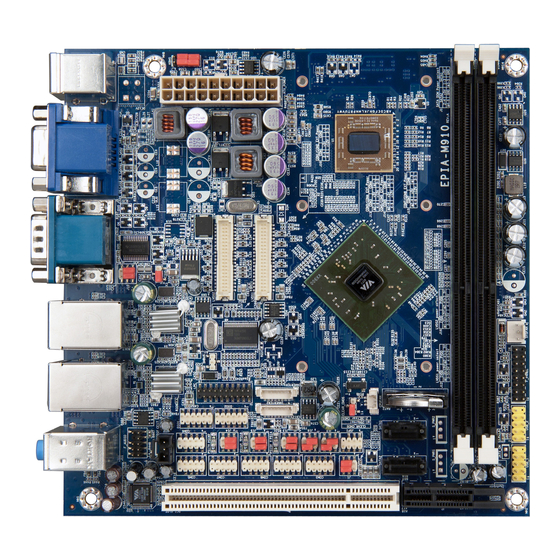
VIA Technologies EPIA-M910 Manuals
Manuals and User Guides for VIA Technologies EPIA-M910. We have 2 VIA Technologies EPIA-M910 manuals available for free PDF download: User Manual
VIA Technologies EPIA-M910 User Manual (107 pages)
Highly-integrated Mini-ITX board with rich feature set and multiple expansion options
Brand: VIA Technologies
|
Category: Motherboard
|
Size: 8 MB
Table of Contents
-
-
-
-
PS/2 Port22
-
VGA Port22
-
COM Port23
-
Audio Jack24
-
HDMI ® Port24
-
USB 2.0 Port25
-
Onboard I/O26
-
-
3 Jumpers
45 -
-
-
PCI Slot58
-
-
Control Keys62
-
Getting Help62
-
Main Menu63
-
-
-
Pmon65
-
-
APM Settings69
-
-
-
DRAM Clock79
-
Panel Type80
-
-
Exit Options83
-
-
-
Epia-M910-1690
-
Epia-M910-12Pq101
-
Idle101
-
RUN Burn-In Test102
-
Epia-M910-12Q103
-
Idle104
-
RUN Burn-In Test104
-
Advertisement
VIA Technologies EPIA-M910 User Manual (136 pages)
Mini-ITX embedded board
Brand: VIA Technologies
|
Category: Motherboard
|
Size: 5 MB
Table of Contents
-
-
-
PS/2 Port28
-
VGA Port29
-
COM Port30
-
Audio Ports32
-
HDMI Port33
-
USB 2.0 Port34
-
-
-
-
3 Jumpers
54 -
-
Control Keys75
-
Getting Help76
-
Main Menu77
-
Amibios77
-
Processor77
-
System Time78
-
System Date78
-
-
Exit Options105
-
-
Epia-M910-16109
-
Epia-M910-16P114
-
Epia-M910-10E118
-
Epia-M910-10Pe123
-
Epia-M910-12Pq127
-
Epia-M910-12Q131
-
Advertisement
Related Products
- VIA Technologies EPIA-M900
- VIA Technologies EPIA-M920
- VIA Technologies EPIA-M920-10E
- VIA Technologies EPIA-M920-12Q
- VIA Technologies EPIA-M930
- VIA Technologies EPIAML8000A - C3 DDR266 6CH Dolby 5.1
- VIA Technologies EPIA-M10000G - VIA Motherboard - Mini ITX
- VIA Technologies EPIA MII-Series Mini-ITX
- VIA Technologies EPIA-M Mini-ITX
- VIA Technologies EPIA-M800

